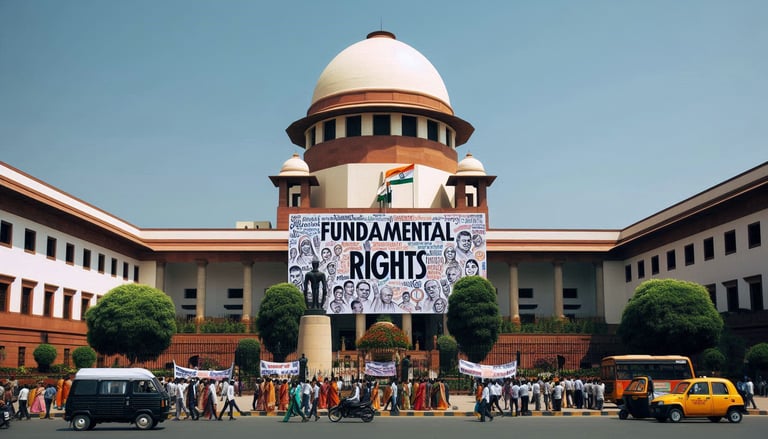Fundamental Rights
Somya Rajawat
Maharani Laxmi Bai Arts and Commerce College, Gwalior, M.P.
This Article is written by Somya Rajawat, a Law Graduate of Maharani Laxmi Bai Arts and Commerce College, Gwalior, M.P.


Introduction: -
Fundamental rights are the basic rights that set the standards for treating every human being equally and respectfully in society. Fundamental rights are those that treat all human beings without discrimination and that work as the backbone of democracy. Fundamental rights not only give specific rights to human beings but also make them understand that they are free to express or enjoy their rights ethically.
Fundamental right: -
Fundamental right is mentioned under part 3 of our Indian Constitution which covers the article from 12 to 35.
[1]Types of fundamental rights: -
Six fundamental rights are mentioned in our Indian Constitution: -
1. Right to Equality,
2. Right to Freedom,
3. Right against exploitation,
4. Right to freedom of religion,
5. Cultural and educational rights,
6. Right to constitutional remedies,
1. Right to equality - (Articles 14 to 18)
The provision of the right to equality is enshrined under Article 14 of the Indian Constitution. It means that any person, whether a citizen or a non-citizen, shall have the right to equality before the law and equal protection of the law, and the territory of India and the state shall not deny it.
Equality before law - It means that the law is blind and does not discriminate on any ground.
Equal protection of law- It means that it provides equal opportunities to equals and should give equal treatment to unequal.
Right to equality also includes Article 1 article 15 16 17 18 which states that there is no discrimination based on religion race sex or place of birth. It also provides equal opportunity in the sector of public employment and it also protects them from untouchability.
2. Right to freedom - (Articles 19 to 22)
The right to freedom is one of the most significant rights. It includes many rights, under which the freedom of speech and expression is an important right. It provides the freedom to express your thoughts appropriately. It also includes the right to assembly, the right to move freely, and the right to practice any profession. The right to freedom not only gives the right to free speech and expression, but it also protects citizens from double jeopardy, meaning that no one can be tried twice for the same offense. Additionally, it protects against self-incrimination. It also includes one of the most important rights, which is the protection of life and personal liberty. This means that having the right to life or personal liberty does not include the right to take your own life. Under the right to freedom, the right to education and protection from detention and arrest is also mentioned.
3. Right against exploitation - (Article 23-24)
"Right against exploitation refers to articles 23 and 24 of the Indian Constitution. It states that the right against exploitation is the protection of human beings from being exploited. It also protects children from being exploited in the form of child labor or trafficking. It states that no child below the age of 14 shall be employed in any work that is hazardous to their health."
4. Right to freedom of religion - (Articles 25 to 28)
The right to freedom of religion refers to sections 25 to 28 of our Indian constitution. Under Article 25 it is said that every person has the right to profess, practice, and propagate religion as per their choice. No one shall be deprived of their right. Articles 26 and 27 give the right to establish or maintain religious institutions and no person is forced or bound to pay tax on any religious subject matter. Under Article 28 they have the freedom to take instructions over religious worship and religious beliefs.
5. Cultural And Educational rights - (Article 29-30)
The cultural and educational right covers articles 29-30 of the Indian Constitution the interest of minorities and its main object is to protect and keep that thing intact.
6. Right to Constitutional remedies: -
The right to constitutional remedies refers to article 32 which states the remedies for enforcement of the right conferred. Article 32 is also known as the heart or soul of the Indian Constitution – said by Dr. B. R. Ambedkar.
It also relates to the maxim- "Ubi jus Ibi remedium" It means where there is a right there is remedy”. It gives the right to a person to move to the Supreme Court if in case their right got breached or infringed. Its simple term means that whenever your right got infringed or breached you have the right to go to the Supreme Court to safeguard your right. [4]
Conclusion: -
A fundamental right gives many privileges in the form of rights; it makes every individual free to live their life without any suffering. Many sets of rights protect citizens from any sort of abusive activities. All citizens are free to express their views without facing any pressure, and no one can discriminate against any person. Every person has the right to have equal opportunity. Therefore, fundamental rights play a significant role in strengthening the body of our Indian constitution.[5].
References
[1] Arpan Malik, ‘Fundamental Rights- Articles 12-35 (Part 3 of Indian Constitution)’ https://byjus.com/free-ias-prep/fundamental-rights/ accessed on October 2024.
[2] Next IAS Team, ‘Fundamental Rights: Meaning, features, Significance & Criticism https://www.nextias.com/blog/fundamental-rights/ accessed on October 2024.
[3] Next IAS Team, ‘Right Against Exploitation (Article 23 to 24): Meaning, Provision & Significance’ https://www.nextias.com/blog/right-against-exploitation/ accessed on October 2024.
[4] Sakshi Kuthari, ‘Fundamental rights under the Indian Constitution’ https://blog.ipleaders.in/fundamental-rights-under-the-indian-constitution-a-comprehensive-guide-with-case-laws/ accessed on October 2024.
[5] Sakshi Kuthari, ‘Fundamental rights under the Indian Constitution’ https://blog.ipleaders.in/fundamental-rights-under-the-indian-constitution-a-comprehensive-guide-with-case-laws/ accessed on October 2024.
